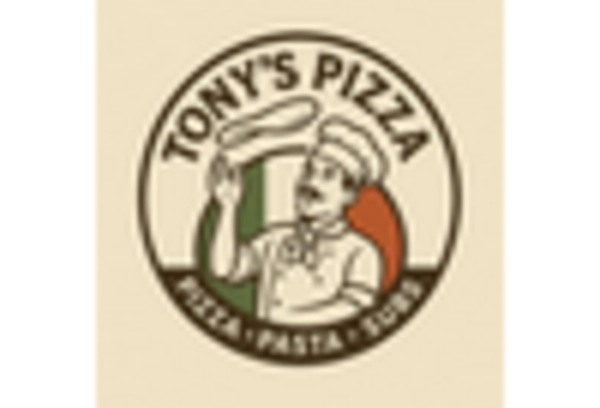Innovative Flavor Profiles
The frozen pizza market is witnessing a transformation driven by the introduction of innovative flavor profiles. Consumers in North America are increasingly adventurous in their culinary choices, seeking unique and gourmet options that go beyond traditional offerings. This trend is reflected in the growing popularity of specialty pizzas, such as those featuring artisanal ingredients or international flavors. Market data indicates that sales of specialty frozen pizzas have increased by 25% over the past year, suggesting a shift in consumer preferences towards more diverse and exciting options. Manufacturers are responding by experimenting with unconventional toppings and flavor combinations, aiming to capture the attention of discerning consumers. This emphasis on innovation not only enhances the appeal of frozen pizzas but also positions the industry to compete with fresh alternatives, thereby driving growth in the market.
Convenience and Time-Saving
The frozen pizza market in North America experiences a notable surge in demand due to the increasing preference for convenience foods. Busy lifestyles and the need for quick meal solutions drive consumers towards frozen pizzas, which offer a ready-to-eat option with minimal preparation time. According to recent data, approximately 60% of households in North America report purchasing frozen pizzas regularly, highlighting their role as a staple in modern diets. This trend is particularly pronounced among working professionals and families, who prioritize efficiency in meal preparation. As a result, manufacturers are expanding their product lines to include a variety of flavors and styles, catering to diverse consumer preferences. The convenience factor is likely to remain a key driver in the frozen pizza market, as more individuals seek hassle-free dining experiences.
Rising Demand for Plant-Based Options
The frozen pizza market is experiencing a significant shift towards plant-based offerings, reflecting broader dietary trends in North America. As more consumers adopt vegetarian and vegan lifestyles, the demand for plant-based frozen pizzas is on the rise. Recent statistics indicate that sales of plant-based frozen pizzas have surged by 30% in the last year, highlighting a growing acceptance of meat alternatives. This trend is particularly appealing to health-conscious consumers who seek nutritious and sustainable meal options. Manufacturers are increasingly incorporating plant-based ingredients into their products, catering to this expanding demographic. The rise of plant-based options not only diversifies the frozen pizza market but also aligns with the increasing consumer focus on health and sustainability, potentially driving further growth in the sector.
Increased Retail Distribution Channels
The frozen pizza market benefits from an expansion of retail distribution channels across North America. With the rise of e-commerce and the diversification of grocery shopping experiences, consumers now have greater access to a wide range of frozen pizza products. Data suggests that online grocery sales have increased by 40% in the past year, with frozen foods, including pizzas, being a significant category. Retailers are also enhancing their in-store frozen food sections, providing consumers with more choices and better visibility of products. This increased accessibility is likely to encourage higher consumption rates, as consumers are more inclined to purchase frozen pizzas when they encounter a broader selection. Consequently, the expansion of distribution channels plays a crucial role in driving growth within the frozen pizza market.
Promotional Strategies and Marketing Campaigns
The frozen pizza market is significantly influenced by effective promotional strategies and marketing campaigns. Companies are increasingly investing in targeted advertising to reach specific consumer segments, utilizing social media and digital platforms to engage with younger audiences. Recent market analysis indicates that brands employing innovative marketing techniques have seen a 20% increase in sales. Promotions, discounts, and limited-time offers are also common tactics used to attract consumers and encourage trial purchases. As competition intensifies, brands are focusing on building strong identities and loyalty among consumers, which is essential for long-term success. The effectiveness of these marketing efforts is likely to continue shaping consumer perceptions and driving sales in the frozen pizza market.

















Leave a Comment